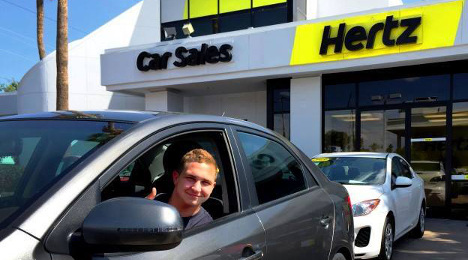Hertz to reduce fleet growth by 100 basis points

Hertz reported that the company disposed of 23 percent of its fleet units during the first quarter through the Hertz Retail and Rent2Buy channels, giving the company a net benefit of about $1,000 per unit. (Photo from Hertz Car Sales Facebook page)
Hertz Global Holdings spent much its most recent financial performance report highlighting that the company is now up to date on all of its filings with the Securities and Exchange Commission. But Hertz also touched on its fleet plans on Friday, sharing a breakdown of how it is disposing of units as well as the volume of new vehicles it’s bringing into its portfolio.
The rental car company reported that it plans to reduce its fleet growth plans for the 2015 fiscal year by 100 basis points, decreasing its previous expansion strategy that ranged from 1.5 percent to 2.5 percent down to 0.5 percent to 1.5 percent. Officials insisted the move “reflects disciplined growth and utilization improvement,” and would leave their total fleet count during the second half of 2015 about 1 percent smaller year-over-year.
Since Hertz began a fleet refresh in September of last year, the company reported that its current average fleet age is four months lower. Hertz also mentioned that 37 percent of its fleet had fewer miles than when the campaign started.
When 2014 closed, Hertz reported in updated SEC filings that it operated a peak rental fleet in the U.S. of approximately 517,500 vehicles, keeping those units for an average of 20 months.
Turning back to its financial presentation, Hertz broke down how it disposed of those units during the first quarter, which concluded on March 31. The company said it moved 44 percent of those units through Hertz Dealer Direct, which gave the company a net benefit of about $300 per unit. Another 23 percent of the units went through the Hertz Retail and Rent2Buy channels, giving the company a net benefit of about $1,000 per unit.
The remaining 33 percent Hertz’s disposed rental fleet ended up going down the auction lanes.
Hertz senior executive vice president and chief financial officer Tom Kennedy emphasized that significant work has been done in managing the company’s fleet, simultaneously controlling costs and driving customer satisfaction.
“We are continuing to make progress to modernize and align the rental car fleet more closely with demand trends, and to improve revenue execution capabilities,” Kennedy said during the company’s quarterly conference call on Friday.
“I want to thank our fleet planning, fleet remarketing, and sales and operations teams for their outstanding execution of a very complex fleet rotation plan,” Kennedy said. “Through their efforts, our customers have begun to take notice of our refreshed fleet.”
Other company news
On Friday, Hertz also highlighted that it has filed its annual report on Form 10-K for the fiscal year ending Dec. 31, which includes the restated results for 2012 and 2013 as well as selected unaudited restated financial information for 2011.
In addition, the company has filed its quarterly report on Form 10-Q for the period ending March 31. The Company is now up to date on all of its filings with the SEC and with its New York Stock Exchange listing requirements.
Hertz went on to mention that it’s progressing with its planned separation of its equipment rental business (Hertz Equipment Rental Corp. or HERC) as well as its capital allocation, cost savings and capacity plans.
“Today's filings are an important step forward, and our attention is now on realizing Hertz’s full potential,” Hertz president and chief executive officer John Tague said. “While much work remains, I thank the Hertz team for their efforts to bring our filings up to date while continuing to remain focused on our customers and our future.
“Going forward, we are committed to developing a differentiated customer experience and premium brand position for Hertz that is No. 1 in the industry, while revitalizing Dollar and Thrifty into leading value brands,” Tague continued. “We aspire to be the best rental car company in the world, recognized for the quality and convenience of our products and services, as well as the value we will create for shareholders.”
Tague went on to say that, “2015 is a transition year for Hertz. We are making important investments in our fleet, systems and service, and adding new talent to complement the existing expertise throughout the company. In addition, we are taking actions to rationalize the company's cost platform, dramatically improve customer satisfaction and reset our capacity.
“These actions and early results are indicative of the progress we are making across the organization,” he added. “Our commitment to the company's share buyback program is reflective of our confidence in driving operating performance that is sustainable and enables us to return capital to shareholders.”

 View The Latest Edition
View The Latest Edition

